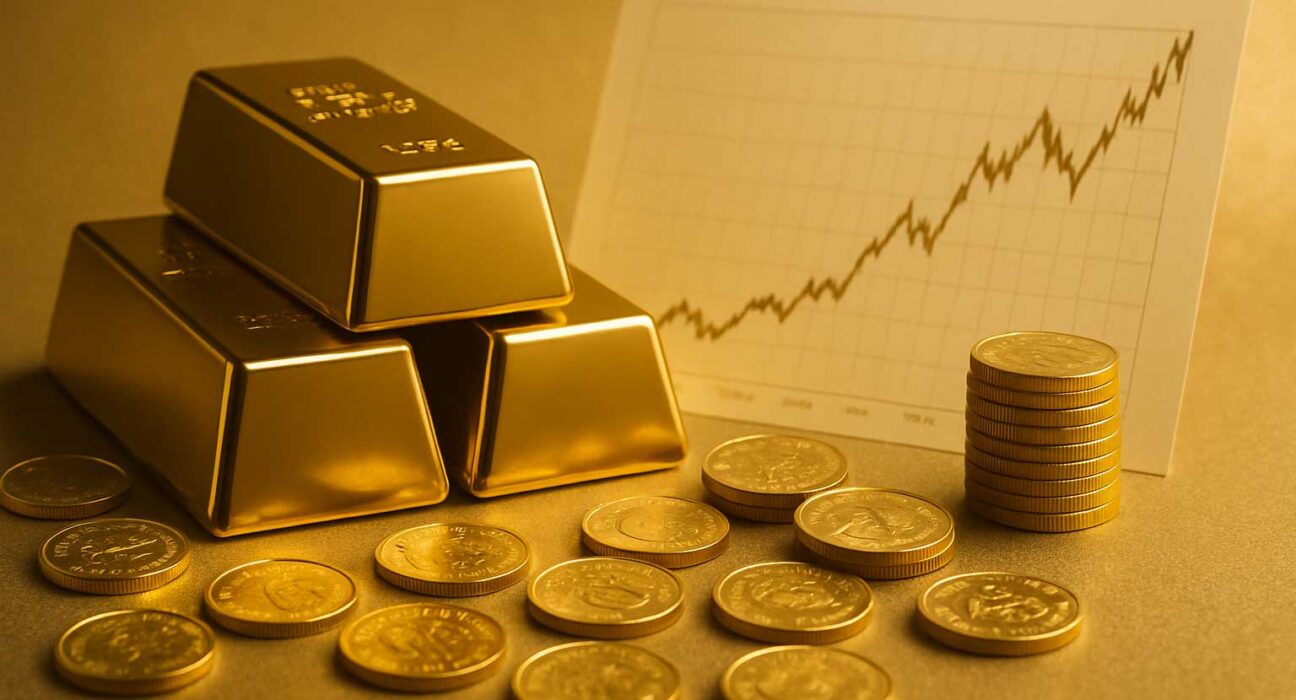Gold has had a monster run lately: it jumped about 26% in the first half of 2025, hitting dozens of new all-time highs. That rally has gotten a lot of investors asking, “Why invest in gold?” The benefits of gold investment go beyond bragging rights. Gold is famous as an inflation hedge and currency hedge, but it’s also a portfolio diversifier and a trusted safe-haven asset when markets wobble. In short, many pros treat gold like insurance: it can protect your wealth when stocks falter or the dollar weakens.
Gold as an Inflation Hedge
Gold’s reputation as an inflation hedge comes from history. It held off wild inflation in the 1970s – during that stagflation, gold prices climbed over 2,300% while inflation topped 14%. More recently, even as U.S. inflation cooled (around 2.9% in late 2024), gold kept surging – up roughly 28% into 2025. In other words, gold is still seen as protection against the future buying-power loss of money. (Financial experts note that in today’s world it’s often better to call gold a hedge against economic uncertainty rather than just inflation.)
That said, gold doesn’t always track every uptick in prices. Its power is most obvious when inflation is driven by deep crises or currency stress. When governments flood markets with money or a currency collapses, gold tends to shine. For instance, central banks around the world have been snapping up gold at record rates as a hedge against monetary turmoil – they added about 1,045 metric tonnes in 2024. In practice, holding some gold means if inflation or currency swings spook the market, your portfolio has something real and hard to hold on to.
Gold for Portfolio Diversification
Gold’s biggest trick is how it smooths out your portfolio. The metal usually moves differently from stocks, bonds, and other assets. In fact, its low (often negative) correlation with equities means gold can cushion losses elsewhere. “Gold has long been part of a well-diversified portfolio,” notes Investopedia. In practical terms, that means when stocks crash or bonds slump, gold often holds firm or even climbs. For example, during the 2008 market crash gold rallied while stocks cratered.
Here are some quick reasons gold diversifies risk:
- Independent Returns: Gold often moves on its own logic, not on Wall Street trends. In the late 1990s when tech stocks soared, gold lagged; when tech stocks crashed in 2008, gold jumped.
- Crisis Cushion: In global crises or wars, investors rush to gold. Recent geopolitical conflicts (in Europe and the Middle East) have boosted gold’s appeal as a crisis commodity.
- Currency Hedge: Gold isn’t tied to any one country. If your local currency tanks, gold (typically priced in dollars) can retain value. That’s one reason central banks hold gold – diversifying currency risk with a “non-government” asset.
- Long-Term Store of Value: Gold has centuries-long credibility. It’s preserved purchasing power across generations. Unlike paper currencies that can be printed at will, the gold supply grows very slowly, so it tends to keep value over the long haul.
Gold as a Safe-Haven Asset
Gold isn’t just a hedge against inflation; it’s a go-to safe haven when fear spikes. Investors flock to gold at the first sign of market trouble, from trade wars to political unrest. As one Investopedia summary puts it, “global economic uncertainty and geopolitical tensions are significant drivers of gold’s appeal since it’s a safe-haven asset”. In the spring of 2025, trade policy fears and continued conflicts helped send gold to new highs. Analysts estimate that fear and uncertainty explained about 4–7% of gold’s recent return, pushing the price higher as people sought safety.
In practice, think of gold like insurance for turmoil: when stock markets swoon or inflation worries hit, gold often rallies. The World Gold Council notes that geopolitical risk has “fed into gold’s appeal as a safe haven,” fueling strong investor demand. In fact, strategists at major banks forecast even higher gold prices if trade disputes or geopolitical strains worsen. (They figure that if a new round of tensions hits, gold could jump another 10–15% from here.) This crisis-proof reputation is why so many investors keep a bit of gold on hand – it can offset losses when everything else is shaky.
Liquidity and Accessibility
It’s worth noting that modern gold investing is easy and liquid. You don’t have to buy heavy bars or hide them in your closet. Today’s gold market is huge and active 24/7 (helped by ETFs, futures, and online platforms), so you can buy or sell quickly. Gold is also no one’s liability – it carries no credit risk (unlike bonds or bank deposits) and is globally recognized. These traits mean you can slot gold into your portfolio and move it in or out as needed, just like a stock or bond fund.
Why It Matters for You
In a nutshell, gold offers multiple benefits for investors. It’s a traditional inflation and currency hedge, a diversifier that can smooth your portfolio returns, and a flight-to-quality asset when uncertainty spikes. Recent market trends reinforce these points: gold’s record rally (up 26% in H1 2025) came when political and economic uncertainty was high, showing its enduring pull.
For individual investors, this means gold can play a strategic role. You typically wouldn’t go “all in” on gold – stocks and bonds should be your core – but allocating a small slice (many experts suggest on the order of 5–10%) can add a valuable layer of protection. In today’s world of unpredictable inflation and sudden shocks, having some gold is like buying optional insurance on your portfolio. It won’t pay dividends, but it holds its ground when nothing else will.
Bottom line: Whether it’s to hedge against rising prices, diversify away from stocks, or park cash in a nervous moment, investing in gold can make sense for many portfolios. Its centuries-long track record, plus recent data on price and demand, underline why savvy investors keep at least a bit of gold on hand.





